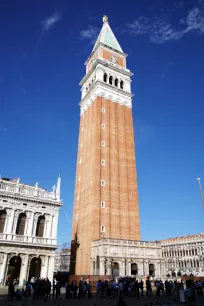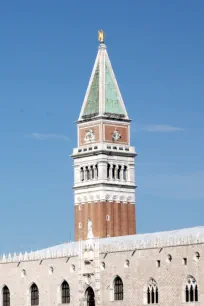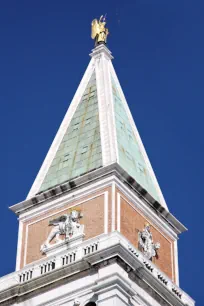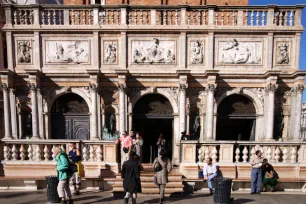The bell tower of the St. Mark’s Basilica is one of Venice’s most recognizable landmarks. The current tower is an early twentieth century reconstruction of the original tower, which collapsed in 1902.




History
The first tower standing at the site of the campanile was built in the seventh century, possibly as a lighthouse. The first clock tower dates from around the year 900. Throughout the centuries, it was rebuilt a number of times, finally reaching its current look around 1513, after a restoration following a damaging earthquake.
The restoration project was initially led by Venetian architect Giorgio Spavento and later taken over by Lombardian architect Bartolomeo Bon. The latter was responsible for the upper part of the tower’s current design, which included the addition of the belfry and the attic. The gold-leaf spire was topped with a gilded wooden statue of the Angel Gabriel. In 1540 the Logetta was added, an ornate podium at the entrance of the tower.
Several calamities hit the tower in the following centuries. Another fire occurred in the early seventeenth century and, this time, Baldassarre Longhena, a well-known Venetian architect of the Baroque period, led the renovations.
In 1745, the Campanile di San Marco was struck by fire again, with the damage causing a collapse that killed several individuals. Subsequent renovations added a lightning rod, and the angel statue was replaced by one sculpted by Luigi Zandomeneghi.
Collapse
On July 14, 1902, the Campanile di San Marco collapsed completely. The Logetta and a small portion of the neighboring Biblioteca Marciana were also destroyed. Local government was quick to decide to rebuild the tower and after ten years of construction, it was reopened April 25, 1912. Care was taken to create an exact copy of the tower as it existed before its collapse, except for some structural reinforcements required to prevent another collapse in the future.
Campanile Specifics
Campanile di San Marco stands 98.6 meters (324 feet) tall and is located near the front of the basilica. Most of the building is simply a plain bricked structure, topped by an arched belfry that houses five bells.
Atop the belfry is another brick section decorated with walking lions (in honor of St. Mark) and the Goddess of Justice, representing Venice. On top of the bell tower is a pyramidal spire with at its peak a golden weather, which is in the form of the angel Gabriel.
The five bells of the Campanile di San Marco each had a specific purpose. The largest rang at the beginning and end of the workday, one rang at midday, another rang to summon members to council meetings, a fourth proclaimed a session of the Senate, and the last announced executions.

At the base of the tower is the Logetta, an ornate podium added in 1540. The Baroque design with marble bas-reliefs and bronze sculptures was created by Jacopo Sansovino, an architect and sculptor from Florence. The bas-reliefs depict allegorical scenes with gods representing Venice, Crete and Cyprus.
Observatory
From the top of the campanile, you have a great view over Venice and the lagoon. Weather permitting, you can see as far as the Alps. Fortunately, you don’t have to walk up the stairs to the observatory, an elevator will bring you straight to the top.
Copycats
Venice’s largest bell tower has been the inspiration for several other towers across Europe and North America. The most famous of these is the Metlife Tower in New York, once the tallest building in the world. Other examples include the Sather Tower in Berkeley, California and the Venetian Towers at the Plaça d’Espanya in Barcelona.
- Next: Zattere
- More Sights & Attractions in Venice

